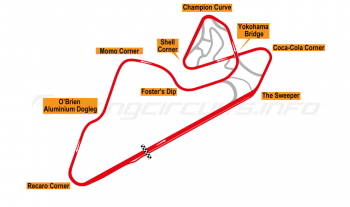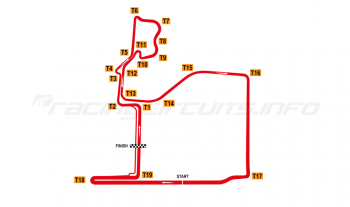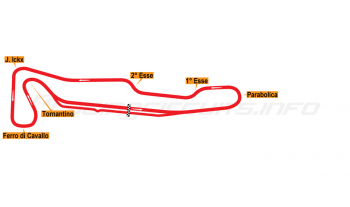The Thermal Club
Circuit Overview
The Thermal Club is an exclusive luxury resort for the well-heeled motorsport enthusiasts, who can enjoy the benefits of a track on their own doorstep. Membership requires the purchase of one of 70 luxury villas overlooking the circuit, creating an exclusive venue which caters for the petrolhead’s every need.
Located in California’s Coachella Valley, the track is effectively its own gated community, with facilities to store, maintain and enjoy all manner of exotic machinery on two and four wheels. First opened in 2014, the track has since expanded in 2015 and 2017 to offer more than five miles in length with multiple layouts, several of which can run simultaneously .
The addition of a BMW and Mini Performance Driving Centre has opened up the facility to non-members, while there are occasional racing club visits, and manufacturer launches, provided members are in favour. The IndyCar Series held its pre-season test at the venue in 2023 and a non-championship race in 2024.
Circuit History
Plans for a resort-style motorsports club out in the deserts of California were first put forward in the early 2000s, when a group of investors keen to take advantage of the area’s rich clientele began the arduous process of gaining permission to build a race track.
The original plans were to follow the more tried-and-tested country club membership approach, similar to those employed at the many golf course resorts that dot the State, where for an annual fee you could turn up, drive the course, enjoy luxury dining and other amenities and then head home.
The location chosen was deliberately remote; in a State such as California where noise and other environmental concerns would significantly hamper operations in urban areas, somewhere a little more out-of-the-way was always preferable. The desert scape and mountain backdrops are certainly spectacular, although the sometimes 50 degree centigrade summer temperatures mean it is not for the faint of heart.
Even so, the process of gaining the required permits from Riverside County took a considerable amount of time, so long in fact that two of the original investors pulled out, frustrated that the development wasn’t heading in the right direction. They would eventually become the outright owners…
Tim Rogers and his wife Twanna are dedicated petrolheads who made a large fortune buying and supplying fuel to 7-Eleven convenience stores and fuel stations , before going on buy the stores they were supplying to. When the Riverside County permits were finally issued, the pair swept in and bought the whole project. They bought back property that had been given away to raise funds and paid off loans with interest.
New vision for membership
The pair’s vision was somewhat different to the original project plan. Rather than a simple country club set up, they wanted to make the track as the centrepiece of a gated community for the ultra-rich petrolhead. To be a member, you have to commit to owning a villa on-site, either by buying one of the ready-made spec villas (which start apart from around $2.3m off-track property or $3.3m for a trackside location) or by buying a plot and committing to build on it within five years.
What was once a $1,200 per month membership fee has doubled over the last five years, on top of a $175,000 initiation fee. That does, however, include a 70 percent refundable deposit should you leave the Thermal Club. Not many do, however, as the mix of speed and a luxury lifestyle seems intoxicating.
The Rogers say they chose the business model after speculating that there were enough people with an interest in a high-octane lifestyle and serious money to burn in a close radius. There was nothing that quite catered to their needs.
“We belonged to several country clubs, and they’re beautiful, with a golf course around you, nice homes, and a common interest with the people near you,” expalins Tim. “But we have maybe 125 of those in the Coachella Valley, and not everyone golfs. We love cars and thought there are many other people who do too.”
While the membership model may seem complex, Thermal Club can supply everything you need to get started, from an architect and contractors and even furnishing for the properties so you can simply turn up and move in. The only proviso is that your vision for the exterior of your bespoke property has to be approved by Thermal Club’s design committee.
Top class track is built
Of course, for the membership model to work, the track needed to be enticing enough to set pulses racing but safe enough to allow amateur drivers and riders to get the most out of their machinery in a safe environment. Renowned track designer Alan Wilson was hired to come up with a plan, blending his experience of designing other country club circuits with the knowledge of penning some of the finest new tracks in the USA, such as Barber Motorsports Park and Calabogie Motorsports Park.
“You want somebody like that to be able to play with their car, push it to their limits. It’s never the car’s limits, because the cars are way better than 90 percent of the drivers,” explains Wilson.
Of course, a project such of this needs scale as well as excitement so, rather than just one course, Wilson penned three, which could be combined into a 5.1 miles long course or be partitioned off so the three courses could be run independently. With up to 20 course variations available, the design ensures that there is always something new and interesting to challenge members.
Motorsport luminary Roger Penske was asked for advice on where to source the asphalt surface that has to cope with the extreme high temperatures Thermal experiences. The Penske simulator was also used to evaluate designs and assess lap speeds. While not a primary aim, the track was penned with a view to some day being suitable for an IndyCar race, or possibly even Formula One — though only if members think such a plan is agreeable.
Circuit opens in phases
Construction began in 2012, with a project plan to develop each of the three courses in separate phases.
Construction began in 2012 and was by no means simple; around 14,000 palm trees had to be relocated before excavators could even come in. Then there was the need to provide the infrastructure not only for the track but the eventual 200 or so villas that would spring up around it.
One of the major features is the 18-foot ‘Great Wall of Thermal’, designed to ensure that any noise from the track is contained, not only from the Thermal Club villas but also from any outside residential developments that might spring up in the future.
The three courses were built in phases. First to arrive was what is known as the South Palm course, opening in 2014. This would be followed by the North Palm course in 2015 and the Desert course in 2017. Each features colour-coded kerbing and trackside paint, with red for South Palm, blue for North Palm and green for the Desert course.
Development has been continual since. The facility now boasts a ‘hotel’ of 8 standalone casitas and three full-service restaurants. Tennis and pickle ball courts, a part of swimming pools, a fitness centre and spa and recreation area for children complete the facilities for residents and their families.
For those on track, here’s a fuel station, car wash, tuning shop and car dealership, so that when members want to swap their Porsche for the latest Ferrari or Lamborghini, the track’s permanent salesman can act as the middleman to secure the best deal. When that new car arrives, it can be housed and maintained in the circuit’s 70-car storage facility.
Thermal hosts testing, eyes a racing future
While Thermal Club is routinely a playground for its members, it does see its track used for other purposes from time to time. Aside from becoming a member, you can pay for the opportunity to lap the course in a BMW or Mini from the West Coast Performance Centre. The German manufacturer is a corporate member, paying around $300,000 a month for the privilege but calculating that it can recoup that expense with an experience which helps clinch thousands of sales each year.
There have also been forays into other uses of the facility; in 2020 it hosted the SRO Organisation for the Pirelli’s World Championship Winter Racing Series, giving its crews and teams of GT3, GT3 and TCR cars the chance to test and enjoy exhibition races.
In 2022 the circuit hit a higher profile, when the IndyCar Series hosted its winter testing exclusively at the venue, using the Twin Palms layout. Improvements had to be made to the pit lane in order to satisfy FIA requirements, however the track was otherwise unmodified.
The two-day IndyCar “Spring Training” was closed to the general public, with only credentialed media outlets, drivers and teams and a limited number of guests allowed alongside Thermal Club members. The track drew praise for its facilities, even if drivers felt it might not be the most useful venue for testing, given its lack of resemblance to anything else on the IndyCar calendar.
Fast forward two years and IndyCar announced that Thermal Club would host a twin-heat non-championship race following on from a two-day Open Test on the Twin Palms layout. The event would feature group qualifying sessions, two heat races and a 12-car “all-star” race with $1.756 million at stake – the largest purse for an IndyCar race outside of the Indianapolis 500.
Jump onboard
Circuit info
- The Thermal Club, 61980 Tyler St, Thermal, CA 92274, United States
- +1 760 674 0088
- Email the circuit
- Official website
Rate This Circuit
Votes: 1724
Plan a visit
Get your race tickets!
Brought to you with: 
We've teamed up with Motorsports Tickets to bring you the best deals for Formula One, MotoGP, Le Mans and more.

























